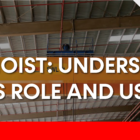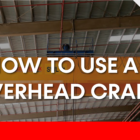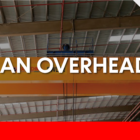EOT Cranes
EOT Cranes, or bridges or overhead cranes, are electricity-powered cranes used in warehouses and industries. EOT Cranes work on rails and under a specific temperature i.e., between -20℃ to 40℃. The primary purpose of EOT or Overhead cranes is to lift and carry heavy loads. EOT cranes come in distinct variants based on girders such as single-girder and double-girder EOT cranes. These cranes are used extensively in the heavy lifting industry, and therefore, undergo frequent wear and tear. But, when it comes to business growth and expansion, no risks can be taken. To elevate the business output, it is a must that the EOT crane runs smoothly.
In its many years of Crane business, Krantechnik Cranes has dealt with a lot of businesses and offered them seamless services from crane supply, and installation to regular maintenance & Safety inspections. So let us understand the nitty-gritty of regular maintenance of EOT Cranes.
Types of Maintenance
When we say ‘Crane maintenance’, it doesn’t refer to a complete checkup of the crane all at once. As it is known, any type of crane is made with many distinct parts and each part requires proper preventive maintenance. Therefore the overall maintenance of the EOT crane has different stages, as below.
- Maintenance of wire ropes: The rope is that essential part of the crane that often undergoes rapid corrosion and abrasion, along with wear and tear due to movement over stationery sheaves. This calls for a regular thorough quality check.
- Maintenance of pulleys – The pulleys are made of hard metal to minimize wear during service, and hence must be checked regularly for possible wear and proper lubrication. Most often flats occur on pulleys through usage and set-up vibration which may result in reduced efficiency and risk of mishap.
- Maintenance of reduction gearbox – During the preventive maintenance of the gearbox, checking the oil casket is a primary step, and post the inspection it must be ensured that no sealing compound enters any oil passage groove in the flanges of the gearbox.
- Maintenance of couplings – At least once a year, the coupling should be inspected for tightness of the connecting bolts and wear in the coupling. The position of the points with respect to the two notches can be used to identify wear from the outside. There has been no wear if the pointer is perfectly between both notches.
- Maintenance of electrical motors – If the insulating resistance is poor, there is always the risk of short-circuiting and motor damage. As a result, measuring the insulating resistance of the motor at the time of installation is beneficial. If the motor makes a loud growling noise, the connection is faulty, and the motor must be stopped immediately. The highest permissible winding temperature, as determined by winding resistance, is 1200°C for B-class insulation and 1400°C for F-class insulation. In the event of significant vibration, inspect the motor and gearbox mounting.
- Maintenance of control panel – The control panel handles all of the crane’s functions. It is made up of a large panel box that houses all of the power and auxiliary contactors, relays, switch gears, and other control equipment. According to the wiring schematic, all equipment inside the panel has permanent identifying labels. Likewise, all power and control terminals must have identifying labels. Once a month or every three months, the power and control terminals should be examined. At switchgear, every terminal and connection must be completely tight.
Safety Inspections:
Another important aspect of regular maintenance is regular inspections. Inspection includes
- Daily Inspection: An everyday inspection is a must before switching the cranes ON for work of the day. There are several steps in the inspection, as follows:
- Check for any loose overhead parts that might cause an unintentional fall.
- Examine the brakes to ensure they are in good operating order.
- Make that the limit/end switches are in good working condition.
- Examine the general condition of the steel wire ropes. If there is any damage that threatens safety, the operator must promptly report it to the supervisor for a thorough examination.
- Check that the wire ropes are adequately oiled – hand lubrication is required.
- Weekly Inspection: This inspection is essentially the same as the daily check, with the exception that the weekly check allows for a more detailed examination of the aforementioned factors when the crane is not in use.
- Reports from operators that needed to be addressed throughout the week but couldn’t because of workload demands are also given the correct attention on the weekends.
- The oil level in the gearbox is checked each week during the inspection, and if necessary, oil is topped up to the indication level.
- The supervisor may perform spot inspections.
- Monthly: In most cases, only quarterly inspections are necessary but if any EOT crane is being used excessively, a monthly inspection may also be needed at times.
- The entire device should be examined for any structural issues and unusual wear and tear.
- Look for any unsecured nuts and bolts.
- Inspect the bearings and pins. Check the sheaves, drums, and lifting equipment.
- Check your wire ropes and hooks. Examine the control system.
- Verify that the brakes are operating properly and replace the lining if necessary.
- Verify the operation of limit switches.
- Examine and clean timers. The timers’ timing should be adjusted.
- Check the fuses and replace any that have blown.
- Perform a thorough inspection of the motors every six months, or on a second quarterly schedule.
- Yearly: The best time to plan annual inspections is during the yearly workshop holidays observed in most factories and industries. Before, initiating the inspection it is foremost to make sure that the previous inspection report is thoroughly referred to.
- The crane’s construction, wear on the travel wheels, brake operation, hoist mechanism, wire ropes, and safety equipment should be given special consideration.
- Oil should be topped out in the gearboxes and all greasing locations should receive careful attention.
- After inspection and repair, a test with a 25% overload and a load in the middle of the span may be conducted.
- With the weight lifted, various movements may be examined.
- Similar inspections can be made on the safety and operation of electrical equipment.
Benefits of EOT Crane maintenance:
- Helps in preventing major damages and fatalities.
- Lesser downtimes
- Smooth and swift functioning
- Major expenses in case of severe faults can be avoided.
Conclusion
Hence, the best way to ensure the proper efficiency of your EOT crane along with safe and secure functioning is to plan your crane maintenance right from the installation period. And most often, if a crane is inspected and maintained on a regular basis, it is less likely to undergo major damage.



